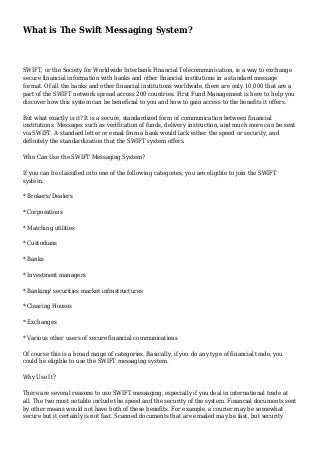
What is The Swift Messaging System?
- 1. What is The Swift Messaging System? SWIFT, or the Society for Worldwide Interbank Financial Telecommunication, is a way to exchange secure financial information with banks and other financial institutions in a standard message format. Of all the banks and other financial institutions worldwide, there are only 10,000 that are a part of the SWIFT network spread across 200 countries. First Fund Management is here to help you discover how this system can be beneficial to you and how to gain access to the benefits it offers. But what exactly is it? It is a secure, standardized form of communication between financial institutions. Messages such as verification of funds, delivery instruction, and much more can be sent via SWIFT. A standard letter or email from a bank would lack either the speed or security, and definitely the standardization that the SWIFT system offers. Who Can Use the SWIFT Messaging System? If you can be classified into one of the following categories, you are eligible to join the SWIFT system. * Brokers/ Dealers * Corporations * Matching utilities * Custodians * Banks * Investment managers * Banking/ securities market infrastructures * Clearing Houses * Exchanges * Various other users of secure financial communications Of course this is a broad range of categories. Basically, if you do any type of financial trade, you could be eligible to use the SWIFT messaging system. Why Use It? There are several reasons to use SWIFT messaging, especially if you deal in international trade at all. The two most notable include the speed and the security of the system. Financial documents sent by other means would not have both of these benefits. For example, a courier may be somewhat secure but it certainly is not fast. Scanned documents that are emailed may be fast, but security
- 2. would be sorely lacking. By sending the same information via a standardized SWIFT message, buyers and sellers alike get the best of both worlds. What Are Some Common SWIFT Messages? MT 799- This is a message that is used when a seller wishes to confirm that a buyer has the funds that will be necessary to complete a specific transaction. A buyer can have his bank issue an MT-799 and it acts a guarantee from the bank that the buyer does currently have funds in their account to execute the transaction. There is no hold put on the funds however, and they are not earmarked in any way for the specific transaction. This means it cannot be considered the same as a bank guarantee or promise to pay. Rather its only purpose is to communicate that the funds to complete the transaction are currently in the account. MT 760- This SWIFT message is very similar to the MT 799, but there are some very important differences. The MT 760 also confirms to the seller that sufficient funds are in the buyer's account, but it puts a hold on said funds and earmarks them for the specific transaction as well. This changes the nature of the MT-760 from being simply a message between banks to being an actual negotiable instrument. MT 199- This is a free format message used in most cases when another SWIFT message does not apply. MT 999- This SWIFT message is exactly the same as the MT 799, except for the fact that it offers a higher level of security. The MT 799 is sent encoded along with a key to decode the message upon arrival. The MT 999 is sent without a key code. This renders it useless without a separate key code, adding a level of security that is necessary in some transactions. MT 542-The MT 542 SWIFT message is related to product delivery. It is used to instruct the delivery of financial Instruments as physical, book-entry, free of payment, or to a specific party. It can also be used to request cancellation of a deliver free of payment order, or to advise of a delivery free of payment that is forthcoming. This article is provided to you by First Fund Management, if interested in more information please visit this website.